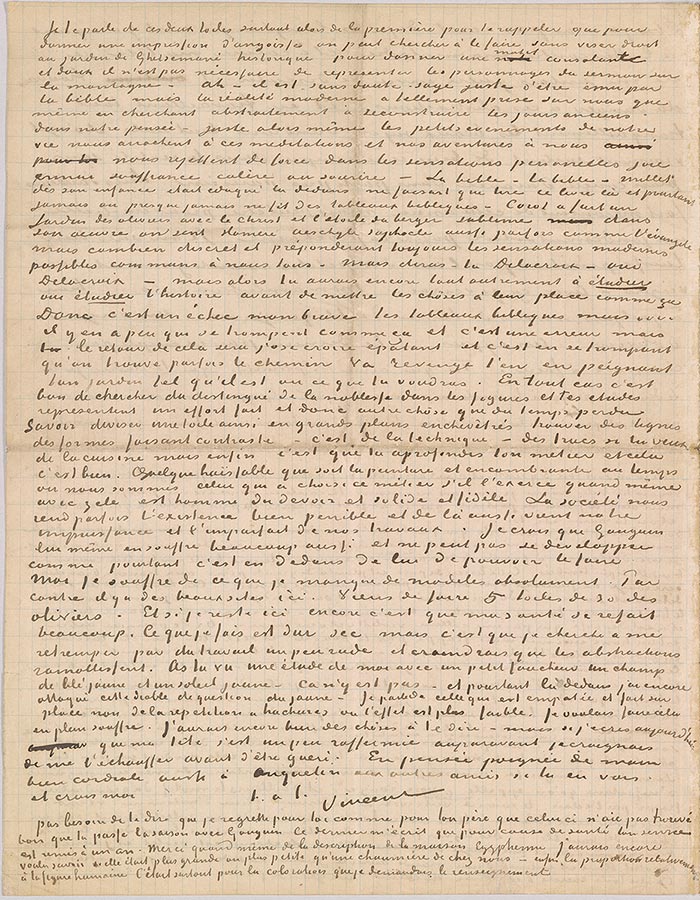
Vincent van Gogh, letter to Émile Bernard, Saint-Rémy, 20 November 1889, Letter 22, page 4
Thaw Collection, given in honor of Charles E. Pierce, Jr., 2007
I am speaking to you of these two canvases, and especially the first, to remind you that in order
to give an impression of anxiety, you can try to do it without heading straight for the historical
garden of Gethsemane; in order to offer a consoling and gentle subject it is not necessary to depict
the figures from the Sermon on the Mount—ah—it is—no doubt—wise, right, to be moved by
the Bible, but modern reality has such a hold over us that even when trying abstractly to reconstruct
ancient times in our thoughts—just at that very moment the petty events of our lives tear us
away from these meditations and our own adventures throw us forcibly into personal sensations:
joy, boredom, suffering, anger or smiling. The Bible—the Bible—Millet was brought up on it from
his childhood, used to read only that book and yet never, or almost never, did biblical paintings.
Corot did a Garden of Olives with Christ and the star of Bethlehem: sublime. In his work you
feel Homer, Aeschylus, Sophocles too, sometimes, as well as the gospels, but how sober and always
giving due weight to modern, possible sensations common to us all. But, you'll say, Delacroix—yes,
Delacroix—but then you'd have to study in a very different way, yes, study history before putting
things in their place like that.
So, they're a setback, my dear fellow, your biblical paintings, but. . . . there are few who make
mistakes like that, and it's an error, but your return from it will be, I dare to say, astonishing, and
it's by making mistakes that one sometimes finds the way. Look, avenge yourself by painting your
garden as it is, or anything you like. In any case, it's good to look for what's distinguished, what's
noble in figures, and your studies represent an effort that's been made, and so something other
than wasted time.
To know how to divide a canvas into large, tangled planes like that, to find contrasting lines
and forms—that's technique—trickery, if you like, but anyway, it means you're learning your craft
more thoroughly, and that's good. No matter how hateful and cumbersome painting may be in the
times in which we live, the person who has chosen this craft, if he nevertheless practices it with
zeal, is a man of duty, both sound and loyal. Society sometimes makes existence very hard for us,
and from that too comes our impotence and the imperfection of our works. I believe that Gauguin
himself suffers greatly from it, too, and cannot develop as he yet has it in him to do.
I myself suffer in that I'm utterly without models. On the other hand, there are beautiful sites
here. Have just done five no. 30 canvases of the olive trees. And if I still stay here it's because my
health is recovering greatly. What I'm making is harsh, dry, but it's because I'm trying to reinvigorate
myself by means of rather arduous work, and would fear that abstractions would make me
soft. Have you seen a study of mine with a little reaper? A field of yellow wheat and a yellow sun.
It isn't there yet—but in it I have again attacked this devil of a question of yellow. I'm talking about
the one that's impastoed and done on the spot, not about the repetition with hatching, in which
the effect is weaker. I wanted to do it in pure sulphur. I'd have plenty more things to tell you—but although I write today that my mind is somewhat stronger, previously I was afraid of overheating it
before I was cured. In thought a very warm handshake, to Anquetin too, to other friends if you see
them, and believe me,
Ever yours,
Vincent
No need to tell you that I regret, for you as well as for your father, that he did not approve of your
spending the season with Gauguin. The latter wrote to me that for reasons of health your service
has been postponed for a year. Thank you anyway for the description of the Egyptian house. I
would still have liked to know if it was larger or smaller than a cottage back home—the size relative
to the human figure, in short. I was looking for information about the coloring in particular.
© 2007 Van Gogh Museum, Amsterdam
